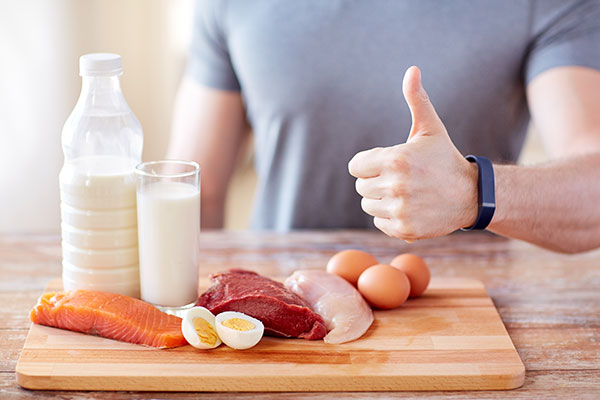New research summarized in the American Journal of Clinical Nutrition backs up the idea that protein is key for shedding unwanted pounds, improving your health, and performing your best.
Eating protein at each meal comes with a variety of benefits, including helping with weight loss and weight maintenance, increasing satiety, preserving lean muscle, and boosting the immune system.
Protein is also an essential factor in exercise recovery.
It provides the amino acids you need to help build muscle. Plus, almost every athlete is familiar with that intense hunger that comes after your daily workout. That hunger can often lead you to overeat and undo all your hard work. This scenario can be prevented with the help of a single nutrient: protein.
Here’s how you can harness the power of protein to help you stay slim, healthy, and perform at your best.
Eat enough protein
The current Recommended Dietary Allowance for protein for both men and women is 0.36 grams for every pound of body weight. This means you should multiply your body weight by 0.36 to figure out how many grams of protein you should consume each day. For example, a 160-pound person needs 58 grams of protein daily. Newer research suggests that protein requirements should increase by about 50 to 100 percent, since higher intake helps with weight and appetite control, as well as improved heart health. For a 125-pound woman, this would mean consuming between 68 and 91 grams of protein daily. A 160-pound man should aim for 86 to 115 grams of protein daily.
Research studies have also shown that with higher protein intake, feelings of fullness during the day are sustained, so you may eat fewer calories overall. Eating protein from food instead of beverages is likely more satisfying since fluids give less of a satiety response.
Each meal matters
Aim for 20-30 grams of protein at each meal to easily increase your protein intake. Snack on foods that supply a good supply of protein compared with fat and carbohydrate. This will up your protein intake throughout the day and make it simple to maintain a higher protein diet in the long-term. Americans generally do not eat enough protein at breakfast, so aim for higher-protein breakfasts centered around eggs, non-fat or low fat dairy, nuts, nut butters, and whole grains. Some research shows that eating protein at breakfast boosts feeling of fullness and reduces snacking later in the day.
Choose high-quality protein sources
Get the most out of your protein by consuming high-quality or “complete” protein sources. High-quality proteins have all the essential amino acids in proportion to our needs. Good animal sources include eggs, wild fish, Greek yogurt, cottage cheese, chicken, turkey, and grass-fed beef. Some of the best plant sources of protein are quinoa, tofu, nuts and legumes.
Beware of too much of a good thing
Protein can help you stay satisfied longer and help you build muscle that will boost your body’s calorie-burning potential. However, eating too much of any kind of food—including protein—will eventually lead to weight gain. Plus, too much protein can have more serious health consequences, including problems with kidney function.
Bottom line
Eating protein at each meal comes with a variety of benefits, including helping with weight loss and weight maintenance, increasing satiety, preserving lean muscle, and boosting the immune system.
By Kristin Price, RD
Try the following recipe to power up your day:
RECIPE: Quinoa Edamame Spinach Salad
A plant-based, protein-packed spinach salad that features two increasingly popular foods – quinoa and edamame. Quinoa, pronounced “keen-wah,” has a wonderful nutty taste and delicate texture. Quinoa is a complete protein because it contains all essential amino acids; it’s also high in fiber, vitamins and minerals. Edamame, pronounced “ed-ah-mah-may” are immature soybeans, meaning they are harvested just before they ripen. Like quinoa, but unlike other legumes, soybeans contain all essential amino acids making them another complete plant protein. Edamame are also high in fiber, vitamins, minerals and phytochemicals.
• 1 cup red quinoa
• 2 cups reduced-sodium vegetable broth
• 2 cups (10 oz.) frozen shelled edamame
• 2 Tbsp. fresh tarragon, chopped (2 tsp. dried)
• 1 Tbsp. lemon zest, freshly grated
• 3 Tbsp. olive oil
• 3 Tbsp. lemon juice
• 3/4 cup jarred roasted red peppers, drained and coarsely chopped
• Salt and freshly ground black pepper
• 1 pkg. (5 oz.) baby spinach
• 1/4 – 1/3 cup chopped walnuts
In large strainer, rinse quinoa well. In large pot over medium heat, toast quinoa until it starts to crackle, about 5 minutes. Add broth and bring to a boil. Cover, reduce heat to low and gently simmer for 12 minutes. Add edamame on top of quinoa. Do not stir or disturb quinoa. Cover again and continue cooking for 10 minutes or until edamame is tender. Carefully drain any remaining liquid. Set aside and let stand for 15 minutes.
In large mixing bowl, add tarragon, zest, olive oil and juice. Gently stir to combine. Reserve 2 tablespoons. Add red peppers and quinoa mixture and toss to combine well. Season to taste with salt and pepper. In another large mixing bowl, gently toss spinach with reserved dressing. Evenly divide spinach among six plates and top with quinoa mixture. Garnish salad with walnuts and serve.
Makes 6 Servings
Per serving: 270 calories, 14 g total fat (1.5 g saturated fat), 30 g carbohydrate, 10 g protein, 6 g dietary fiber, 150 mg sodium.


